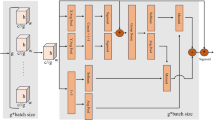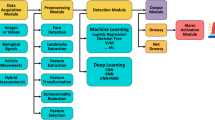Abstract
With the advancement in urbanization, it is extremely challenging to find a vacant parking space in a densely populated area. Many researchers experienced that traditional vision-based parking slot status detection approaches are more time consuming and cannot handle large video frames in practical applications, which diverted many researchers toward deep learning methods that can extract features and classify it. This study proposes an ensemble model based on deep learning to tackle weather condition effects. In most cases, Convolutional Neural Networks (CNN’s) models used Red, Green, Blue frames, but it was observed that many more techniques like Hue Saturation Value, Discrete Wavelet Transform, Discrete Cosine Transform and GRADIENT also play an important role, if trained well using deep learning. Proposed study includes training of CNN’s network considering five techniques followed by weighted fuzzy model. In this research, experiments have been conducted on a publicly available "PKLot" dataset, which consisted of 12,417 images which have been segmented into 695,899 images such that each segmented image represents the individual parking slot. Images have been taken from three different camera locations in two different parking lots in Brazil, under different weather conditions such as sunny, cloudy and rainy. The experimental results show significant improvement in terms of accuracy as compared with existing state-of-art methods. In the end, real-time images of outdoor parking lot of Panjab University Swami Sarvanand Giri Regional Centre, Hoshiarpur, Punjab, India have been collected for implementation of the proposed model.









Similar content being viewed by others
References
López Sastre, R.J., Gil Jiménez, P., Acevedo, F.J., Maldonado Bascón, S.: Computer algebra algorithms applied to computer vision in a parking management system. In IEEE Int. Symp. Ind. Electron., pp. 1675–1680 (2007). https://doi.org/10.1109/ISIE.2007.4374856.
Maclin, R.: Popular ensemble methods: an empirical study popular ensemble methods: an empirical study. J. Artif. Intell. Res. 11(July), 169–198 (2016). https://doi.org/10.1613/jair.614
Wang, C., Zhang, H., Yang, M., Wang, X., Ye, L., Guo, C.: Automatic parking based on a bird’s eye view vision system. Adv. Mech. Eng. (2014). https://doi.org/10.1155/2014/847406
Badii, C., Nesi, P., Paoli, I.: Predicting available parking slots on critical and regular services by exploiting a range of open data. IEEE Access 6, 44059–44071 (2018). https://doi.org/10.1109/ACCESS.2018.2864157
Ahrnbom, M., Astrom, K., Nilsson, M.: Fast classification of empty and occupied parking spaces using integral channel features. In: IEEE Comput. Soc. Conf. Comput. Vis. Pattern Recognit. Work., pp. 1609–1615 (2016). https://doi.org/10.1109/CVPRW.2016.200.
Tschentscher, M., Koch, C., König, M., Salmen, J., Schlipsing, M.: Scalable real-time parking lot classification: An evaluation of image features and supervised learning algorithms. In: Proceedings of the International Joint Conference on Neural Networks, Sep. 2015, vol. 2015-September. https://doi.org/10.1109/IJCNN.2015.7280319.
Amato, G., Carrara, F., Falchi, F., Gennaro, C., Meghini, C., Vairo, C.: Deep learning for decentralized parking lot occupancy detection. Expert Syst. Appl. 72, 327–334 (2017). https://doi.org/10.1016/j.eswa.2016.10.055
Amato, G., Carrara, F., Falchi, F., Gennaro, C., Vairo, C.: Car parking occupancy detection using smart camera networks and deep learning. In: Proceedings—IEEE Symposium on Computers and Communications, Aug. 2016, vol. 2016-August, pp. 1212–1217. https://doi.org/10.1109/ISCC.2016.7543901.
Nurullayev, S., Lee, S.-W.: Generalized parking occupancy analysis based on dilated convolutional neural network. Sensors 19(2), 277 (2019). https://doi.org/10.3390/s19020277
Bdair, A.H., Abdullah, R., Manickam, S., Al-Ani, A.K.: Computational Science and Technology, vol. 603(August) (2020).
Acharya, D., Yan, W., Khoshelham, K.: Real-time image-based parking occupancy detection using deep learning. CEUR Workshop Proc., vol. 2087, pp. 33–40 (2018)
Paidi, V., Fleyeh, H.: Parking occupancy detection using thermal camera. In: VEHITS 2019—Proc. 5th Int. Conf. Veh. Technol. Intell. Transp. Syst., pp. 483–490 (2019). https://doi.org/10.5220/0007726804830490
Singh, T., Sardar, S.: Smart parking for slot occupancy detection using prewitt edge detection in OpenCV. Int. J. Comput. Appl. 178(32), 1–6 (2019). https://doi.org/10.5120/ijca2019918997
Tuncer, T., Yar, O.: Fuzzy logic-based smart parking system. Ing. des Syst. d’Information 24(5), 455–461 (2019). https://doi.org/10.18280/isi.240501
Chunhe, Y., Jilin, L.: A type of sensor to detect occupancy of vehicle berth (2004)
Wolff, J., Heuer, T., Gao, H., Weinmann, M., Voit, S., Hartmann, U.: Parking monitor system based on magnetic field sensors. In: IEEE Conference on Intelligent Transportation Systems, Proceedings, ITSC, 2006, pp. 1275–1279. https://doi.org/10.1109/itsc.2006.1707398
Suhr, J.K., Jung, H.G.: Automatic parking space detection and tracking for underground and indoor environments. IEEE Trans. Ind. Electron. 63(9), 5687–5698 (2016). https://doi.org/10.1109/TIE.2016.2558480
Kotb, A.O., Shen, Y.C., Huang, Y.: Smart parking guidance, monitoring and reservations: a review. IEEE Intell. Transp. Syst. Mag. 9(2), 6–16 (2017). https://doi.org/10.1109/MITS.2017.2666586
Tang, C., Wei, X., Zhu, C., Chen, W., Rodrigues, J.J.P.C.: Towards smart parking based on fog computing. IEEE Access 6, 70172–70185 (2018). https://doi.org/10.1109/ACCESS.2018.2880972
Geng, Y., Cassandras, C.G.: New “Smart Parking” system based on resource allocation and reservations. IEEE Trans. Intell. Transp. Syst. 14(3), 1129 (2013). https://doi.org/10.1109/TITS.2013.2252428
Zhu, H., Yu, F.: A vehicle parking detection method based on correlation of magnetic signals. Int. J. Distrib. Sens. Netw. 11, 361242 (2015). https://doi.org/10.1155/2015/361242
Chen, M., Chang, T.: A parking guidance and information system based on wireless sensor network. In: 2011 IEEE Int. Conf. Inf. Autom. ICIA 2011, pp. 601–605 (2011).https://doi.org/10.1109/ICINFA.2011.5949065
Baroffio, L., Bondi, L., Cesana, M., Redondi, A.E., Tagliasacchi, M.: A visual sensor network for parking lot occupancy detection in Smart Cities. In: IEEE World Forum on Internet of Things, WF-IoT 2015—Proceedings, 2015, pp. 745–750. https://doi.org/10.1109/WF-IoT.2015.7389147
Gowda, S.N., Yuan, C.: ColorNet: Investigating the importance of color spaces for image classification, 1–17
Bendjillali, R.I., Beladgham, M., Merit, K., Taleb-Ahmed, A.: Improved facial expression recognition based on DWT feature for deep CNN. Electronics (2019). https://doi.org/10.3390/electronics8030324
Jain1989_Fundamentals of Digital Image Processing.pdf
Krizhevsky, A., Sutskever, I., Hinton, G.E.: ImageNet classification with deep convolutional neural networks. http://code.google.com/p/cuda-convnet/
Simonyan, K., Zisserman, A.: Very deep convolutional networks for large-scale image recognition. In: 3rd Int. Conf. Learn. Represent. ICLR 2015—Conf. Track Proc., pp. 1–14 (2015)
Chollet, F.: Xception: Deep learning with depthwise separable convolutions. In: Proc.—30th IEEE Conf. Comput. Vis. Pattern Recognition, CVPR 2017, vol. 2017-Jan, pp. 1800–1807 (2017). https://doi.org/10.1109/CVPR.2017.195.
Szegedy, C., Vanhoucke, V., Ioffe, S., Shlens, J., Wojna, Z.: Rethinking the inception architecture for computer vision. In: Proc. IEEE Comput. Soc. Conf. Comput. Vis. Pattern Recognit., vol. 2016-Dec, pp. 2818–2826 (2016). https://doi.org/10.1109/CVPR.2016.308.
He, K., Zhang, X., Ren, S., Sun, J.: Deep residual learning for image recognition
Aggarwal, A., Mittal, M., Battineni, G.: Generative adversarial network: An overview of theory and applications. Int. J. Inf. Manage. (2021). https://doi.org/10.1016/j.jjimei.2020.100004
Singh, P.P., Khosla, P.K., Mittal, M.: Energy conservation in IoT-based smart home and its automation. In: Mittal, M., Tanwar, S., Agarwal, B., Goyal, L. (eds.) Energy Conservation for IoT Devices. Studies in Systems, Decision and Control, vol. 206. Springer, Singapore (2019)
Kaur, S., et al.: Mixed pixel decomposition based on extended fuzzy clustering for single spectral value remote sensing images. J. Indian Soc. Remote Sens. 47(3), 427–437 (2019). https://doi.org/10.1016/j.compeleceng.2018.08.018
Singh, R., Gahlot, A., Mittal, M.: IoT based intelligent robot for various disasters monitoring and prevention with visual data manipulating. Int. J. Tomogr. Simul 32(1), 90–99 (2019)
Sanjeewa, E.D.G., Herath, K.K.L., Madhusanka, B.G.D.A., Priyankara, H.D.N.S.: Visual attention model for mobile robot navigation in domestic environment. GSJ 8(7), 2020 (2020)
Ghansiyal, A., Mittal, M., Kar, A.K.: Information management challenges in autonomous vehicles: a systematic literature review. J. Cases Inf. Technol. 23(3), 58–77 (2021). https://doi.org/10.4018/JCIT.20210701.oa5
Mittal, M., Kumar, M., Verma, A., Kaur, I., Kaur, B., Sharma, M., Goyal, L.M.: FEMT: a computational approach for fog elimination using multiple thresholds. Multimed. Tools Appl. 80(1), 227–241 (2021). https://doi.org/10.1007/s11042-020-0965
Author information
Authors and Affiliations
Corresponding author
Rights and permissions
About this article
Cite this article
Mago, N., Kumar, S. & Goyal, L.M. Real Time Fuzzy based Intelligent Parking Detection System Using Deep Learning Techniques. Int. J. Fuzzy Syst. 24, 2560–2568 (2022). https://doi.org/10.1007/s40815-021-01212-9
Received:
Revised:
Accepted:
Published:
Issue Date:
DOI: https://doi.org/10.1007/s40815-021-01212-9




